監製:Diana Wan
Even for the non-religious, Christmas is one of the best times for many to come together with families and friends. The Arab World is home to some of the world’s oldest Christian communities. Later on the show, the local band The Saffron will be playing us some traditional Middle Eastern music. But first, a new form of sports, and one that may come as a surprise to you. It’s called Theatresports, and it is an artistic form developed in Canada.
At M+ you can catch an immersive exhibition of twelve environments created by women artists between the 1950s and the present day. Three of those environments are newly commissioned works by Asian women. Titled “Dream Rooms”, this selection of works was first staged in 2023 at Haus der Kunst in Munich, Germany. The travelling exhibition on show at M+ is the first edition in Asia. Audience engagement is an active part of the experience, so shoes off and dive in.

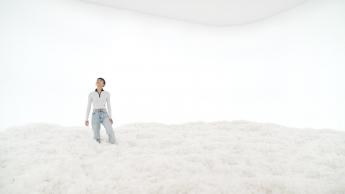
Even for the non-religious, Christmas is one of the best times for many to come together with families and friends. The Arab World is home to some of the world’s oldest Christian communities. Later on the show, the local band The Saffron will be playing us some traditional Middle Eastern music. But first, a new form of sports, and one that may come as a surprise to you. It’s called Theatresports, and it is an artistic form developed in Canada.
At M+ you can catch an immersive exhibition of twelve environments created by women artists between the 1950s and the present day. Three of those environments are newly commissioned works by Asian women. Titled “Dream Rooms”, this selection of works was first staged in 2023 at Haus der Kunst in Munich, Germany. The travelling exhibition on show at M+ is the first edition in Asia. Audience engagement is an active part of the experience, so shoes off and dive in.
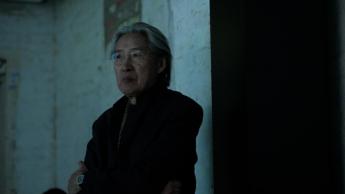
In much of the world Basil Pao is probably best known for his work as the primary photographer for several BBC travel series with presenter Michael Palin. They’ve collaborated on eleven books covering an assortment of voyages. Pao has also worked as a stills photographer and actor on Bernardo Bertolucci’s “The Last Emperor”.
A current exhibition at Tai Kwun features two series of Pao’s works, “The Great Walls of China” and “Glimpses of Silence”, that explore the relationship between heritage and artistic creation.
Based in Berlin, Germany, cellist Alex Lau is pursuing a bachelor’s degree at the Munich University of Music and Performing Arts. He was in Hong Kong for a recital in September as part of the Leisure and Cultural Services Department’s “Hong Kong Artists” series. As a young musician, Lau likes to expand the possibility of the cello by incorporating other art forms such as dance. He’s previously collaborated with choreographer Jacopo Godani and the Dresden Frankfurt Dance Company.
A keen chamber music enthusiast he also organised a chamber music festival with his brother, a violist in Munich, in October.

Percussionist Samuel Chan is currently a fellow with the Hong Kong Philharmonic Orchestra under the Orchestra Academy Hong Kong programme. As well as performing as a soloist, he is a member of the group, The Up:Strike Project. He’ll be joining us later. Before that though, we’re looking at a highly percussive form of dance: tap dance. Originating in the United States some 300 years ago, born of Irish and West African step dance traditions, it often accompanied jazz music, as dancers improvised to jazz music. And there are tap dance aficionados in Hong Kong too, where one dance group not only focuses on the art form but is also keen to inject new ideas into it.
At Flowers Gallery Hong Kong, "Roadkill", Stuart Pearson Wright’s first solo exhibition in Asia, presents several portraits painted in the past five years. In this new series of works, Wright blends human figures and animal traits, also incorporating everyday objects, with theatrical exaggeration and humour. “These paintings,” he says, “embrace the ridiculous because sometimes laughter feels like the only way out of despair.”
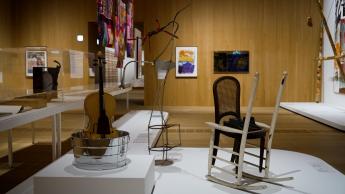
For more than six decades of artistic creation, Robert Rauschenberg worked in a wide variety of mediums, such as painting, sculpture, prints, photography and performance. Now showing at M+ is a major exhibition that highlights Rauschenberg’s connection with Asia.
"Body is Landscape” at the Axel Vervoordt gallery - Ann Leda Shapiro’s first solo exhibition in Asia - highlights her over-riding interests in social awareness, commitment to care, and the interplay of personal experience and the wider world.
Singer-songwriter Elly C said writing songs is like a therapy for her. It’s an outlet for her to channel thoughts that she couldn’t talk about with her friends and family. As an independent musician, she also produces her own music. After making music on her own since 2020, she is now collaborating more with other musicians. She’s here to tell us more about her music-making and to bring us one of her early song, “Nobody’s watching”.
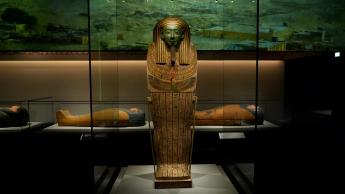
On 1st November, the Grand Egyptian Museum (GEM) in Giza had a spectacular three-day opening ceremony in the Giza Plateau in Egypt. After two decades and an estimated cost of US$1.2 billion, the museum finally opens its doors to the public on 4th November. The museum spans nearly 500,000 square metres with more than 100,000 artefacts and is described as the world’s largest archeological museum. Egyptian officials expected the museum to attract up to 8 million visitors a year. Although we might not be able to go to GEM in Giza right now, we are lucky enough to see 250 ancient artefacts from Egypt in a newly opened exhibition at the Hong Kong Palace Museum.
Now in its third edition, this year’s Sigg Prize is shortlisting six artists. The prize was set up in 2018 with the aim of recognising and promoting the strength and diversity of Chinese artists on an international platform. New and recent works by the six shortlisted creators are on show at The Studio in M+ until 4th January next year.
Grammy Yeung majored in the guzheng, a Chinese plucked zither in her Masters degree at the Hong Kong Academy for Performing Arts. She is also a music major graduate from The University of Hong Kong. On 1st December, she will be having her recital as part of the Leisure and Cultural Services Department’s “Hong Kong Artists” series.
She is here to tell us more about the programme of the upcoming concert.
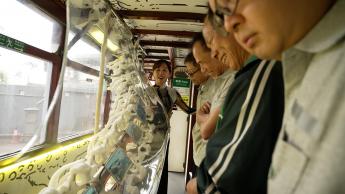
In August, vocalist, printmaker and painter Julie May came to our studio to talk about the importance of interdisciplinary practices in her work. That chat focused mostly on her music. Today, we’re going to talk to her in more detail about her visual art and printmaking. First though, in 2022, the Hong Kong Arts Development Council launched the Arts∙Tech exhibition series to encourage the public to engage with multi-disciplinary arts. This year’s Arts∙Tech 3 has two installments, the first of which, in June and July, took the form of a lighthouse installation on the observation deck in Ocean Terminal. The second installment, which focuses on urban culture and future developing involves a moving Hong Kong icon, the double-decker tram often colloquially known as the Ding Ding.
"Stay Connected: Art and China Since 2008” is a two-part exhibition at Tai Kwun JC Contemporary, the first part of which is on show until the 4th January. "Stay Connected: Navigating the Cloud” includes more than 50 works by over 35 artists and groups. They explore the relationship between digital technology, the manufacturing supply chain and human activities, and their impacts on social realties and art in China.
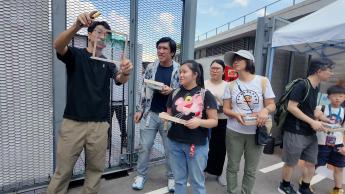
The jazz club Chez Trente’s third edition, CT Music Fest is just round the corner. One of the participating musicians is Jonas Cho and his jazz band. He’s here later on the show for a chat to let us know more about it. And to play us a jazz version of a famous Chinese lullaby. But first, let’s talk a walk. In this mostly milder weather, it’s a good time to check out the western section of the East Coast Boardwalk under North Point’s Island Eastern Corridor. Opened early this year, the boardwalk is a beautiful 2.2 km route with a spectacular view of the harbour. It’s divided into two sections, and has many highlights for the public to enjoy, including a community space called “Quarryside”.
This year is the 120th anniversary of the birth of the master painter Chao Shao-an. The Hong Kong Heritage Museum is currently presenting a retrospective exhibition featuring his much-loved bird-and-flower paintings and including rarely seen works on loan from his family, local museums, and private collectors.
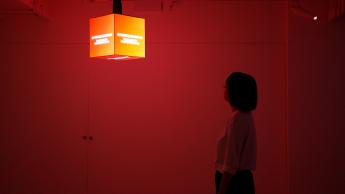
Due to light pollution and cloudy weather, it isn’t always so easy to see celestial bodies above Hong Kong, but you do have an opportunity to see and reflect on the stars and their symbolism and meaning at “The Orbit of Hope”, an exhibition organised by the non-profit art platform WMA. Four artists are taking part. We talked to one of them, Jess Lau.
The exhibition “Misty Aura” at Hanart TZ Gallery features more than 20 large-scale shanshui or landscape paintings painted over the past 12 years by artist Xu Longsen.
Pianist Niu Niu revisited us in February, just after the Lunar New Year, and spoke to us about his performances of all three of Tchaikovsky’s piano concertos with the Hong Kong Philharmonic Orchestra, one of which resulted in a live album. He also highlighted his plans for the rest of 2025, which included a debut recital in Singapore in August, and a series of concerts in Japan, beginning this month and continuing into November. Niu Niu also told us that one of his goals for this year, apart from performing, is to write more of his own music. While he was with us, he performed one of his original compositions, a piece from his “Weather Suite” called “Sunny Day”.

Ceramics can be produced using moulds, or by hand-building techniques that include kneading the clay, pinching, coiling, rolling, throwing on a wheel, and slab construction. But one Hong Kong ceramic artist, Silvester Mok, is working with a new technique: 3D printing.
"In the Meantime” at WKM Gallery is the debut Hong Kong exhibition of Yukari Nishi who describes her process and approach to painting as a form of “collage therapy”.
The paintings, which present her exploration of the surreal as a place of escape and reflection, reflect her reality and anxiety as a mother.
Jason Kui is best known for his electrifying guitar playing. A rock and blues musician and composer, his musical range includes modern metal, hard rock, funk and ballads. In September 2022, Kui came to our studio to give us a preview of his two then upcoming concerts: “Six-String Journey to the West”. Music from that show was released as a live album in May this year, and he’s here to tell us more about that, and give us a sneak peek of a new song, due to be released next month.
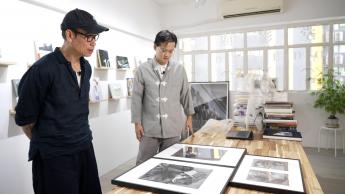
There are more than a hundred art galleries in Hong Kong, but only a handful specialise in photography. Recently, a new one opened in Wong Chuk Hang, primarily focusing on photobooks by photographers from around the world, particularly from Japan.
Currently showcasing at gdm, or Galerie du Monde, is "New Territories", the debut solo exhibition of Gordon Cheung, Featuring both paintings and sculpture, the exhibition explores such themes as colonial history, identity, territory, and sense of belonging, through references to Cheung’s ancestral lineage as well as Hong Kong’s own past and future.
In June, the Romer String Quartet came to our studio to talk about a concert that focused on Claude Debussy’s only string quartet, composed in 1893. One member, relatively new to the quartet, is violinist Chow Yip-wai. Before joining them, he played with several ensembles in Hong Kong, including the Cong Quartet, Musicus Soloists Hong Kong, and more. As a soloist, Chow is active both in Hong Kong and in the United States. He is also an educator, sharing his love for music with students at the Chinese University of Hong Kong and the West Virginia State University. This Thursday, he’s giving a recital presented by the New Hong Kong Philharmonia. He’s with us now.